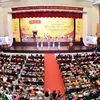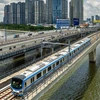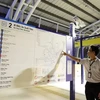Energy shortages have become a serious concern, directly affecting people's daily lives, but green architecture could provide a solution to the problem.
According to experts, green architecture would lower electricity bills even as power tariffs are on the rise. Costs for healthcare and treatment will also begin to fall if the environment is filled with less dust and fewer toxins.
Former deputy minister of Natural Resources and Environment Dang Hung Vo explained that green architecture meast environmentally responsible building for sustainable development in residential areas.
The architecture focuses on improving the effective use of energy, water and materials to reduce the negative impact of construction on people's health and the environment.
"Green architecture is up and coming in Vietnam and should be a major industry in the future," said chairman of the Vietnam Association of Architecture Nguyen Tan Van.
Van noted that trends in architecture all over the world are beginning to connect structural design with modern technology and energy saving.
"Huge urban areas with populations of over 10 million people have popped up not only in America but also in Asian countries, especially in India, Japan, China and Vietnam, raising concerns about crowding and pollution," he added.
He said these cities could conceivably lead to a reduction in living standards and climate change.
Figures released by the World Bank show that Vietnam has the highest rate of urbanisation in Southeast Asia, which can be seen in big cities like Hanoi, HCM City, Da Nang and Hai Phong.
In 1986, the number of Vietnamese people living in urban areas was 18 million but last year that figure reached 26.3 million.
Deputy Prime Minister Hoang Trung Hai told the 16th Conference on Architecture in Asia, held in Da Nang, that urban areas in Vietnam are facing global challenges including rapid population growth, failing infrastructure, lack of healthcare services, poor education, and traffic congestion.
Le Thi Bich Thuan, deputy director of the Construction Ministry's Institute of Urban Architecture, Planning and Rural Areas, said energy in the country's buildings (especially in households and public high-rises) has accounted for 24 percent of the total consumption since 1994.
"The rate has rapidly risen in the past few years due to development in urban areas and the increase in foreign direct investment," Thuan said.
She said investors have not paid enough attention to energy saving solutions, ignoring their socio-economic benefits, while public constructions used old-fashioned technologies.
Surveys from the Ministry of Science and Technology showed that shortcomings in design had resulted in a 20 to 30 percent loss of energy consumption in buildings.
Vietnam lacked specific regulations for building licences to ensure energy saving.
Chairman of the Vietnam Architecture Association Van said building eco-cities would support sustainable development at the local level. But he noted that there should be careful planning and preparation before implementing energy saving measures./.
According to experts, green architecture would lower electricity bills even as power tariffs are on the rise. Costs for healthcare and treatment will also begin to fall if the environment is filled with less dust and fewer toxins.
Former deputy minister of Natural Resources and Environment Dang Hung Vo explained that green architecture meast environmentally responsible building for sustainable development in residential areas.
The architecture focuses on improving the effective use of energy, water and materials to reduce the negative impact of construction on people's health and the environment.
"Green architecture is up and coming in Vietnam and should be a major industry in the future," said chairman of the Vietnam Association of Architecture Nguyen Tan Van.
Van noted that trends in architecture all over the world are beginning to connect structural design with modern technology and energy saving.
"Huge urban areas with populations of over 10 million people have popped up not only in America but also in Asian countries, especially in India, Japan, China and Vietnam, raising concerns about crowding and pollution," he added.
He said these cities could conceivably lead to a reduction in living standards and climate change.
Figures released by the World Bank show that Vietnam has the highest rate of urbanisation in Southeast Asia, which can be seen in big cities like Hanoi, HCM City, Da Nang and Hai Phong.
In 1986, the number of Vietnamese people living in urban areas was 18 million but last year that figure reached 26.3 million.
Deputy Prime Minister Hoang Trung Hai told the 16th Conference on Architecture in Asia, held in Da Nang, that urban areas in Vietnam are facing global challenges including rapid population growth, failing infrastructure, lack of healthcare services, poor education, and traffic congestion.
Le Thi Bich Thuan, deputy director of the Construction Ministry's Institute of Urban Architecture, Planning and Rural Areas, said energy in the country's buildings (especially in households and public high-rises) has accounted for 24 percent of the total consumption since 1994.
"The rate has rapidly risen in the past few years due to development in urban areas and the increase in foreign direct investment," Thuan said.
She said investors have not paid enough attention to energy saving solutions, ignoring their socio-economic benefits, while public constructions used old-fashioned technologies.
Surveys from the Ministry of Science and Technology showed that shortcomings in design had resulted in a 20 to 30 percent loss of energy consumption in buildings.
Vietnam lacked specific regulations for building licences to ensure energy saving.
Chairman of the Vietnam Architecture Association Van said building eco-cities would support sustainable development at the local level. But he noted that there should be careful planning and preparation before implementing energy saving measures./.



















